Antenna Grounding
- Coax cable grounding
: Antenna
Hookup digital and analog TV
HOME
• How to hookup Surround Sound for Netflix, Hulu
o DVR
for free TV cord cutters
Antenna Grounding:
Outside antennas for TV - Lightning Protection
ANTENNA, CATV GROUNDING
Grounding outside TV antennas and cable TV coaxial cables:
Outside TV antennas should be grounded to prevent damage to your
equipment from static electricity particularly during a thunderstorm.
Lightning travels mostly in a straight line with a final goal of
hitting the earth and it will follow the path of least resistance, so
any sags or bends in the ground wire is a place where the lightning can
"jump" out.
Keep in mind that in the rare event you sustain a direct
lightning strike, nothing is guaranteed, even with a ground. There is
nothing you can do to 100% prevent damage to your gear if you get a
direct lightning strike. The good news is a direct lightning strike is
very rare.
Most likely you will never get a direct strike. The
antenna mast itself must be grounded and the coax cable also must be
grounded. The coax cable, usually RG-6, needs to be grounded so a surge
in current does not enter your equipment and destroy expensive
components like a digital TV set.
The goal is to prevent a buildup of static electricity in the first
place and to try to keep damage from occuring to sensitive diodes and
circuits in your electronic components. A grounding block
is used to
ground the outside antenna. You will want to try to keep the static
electricity outside your house. Never run the wires inside your house.
Run the wires straight from the antenna mast to ground and keep the
length as short and straight as possible.
Ground is defined as a rod
driven 8 ft. into the earth. If hard soil prevents driving a metal rod
8 ft. deep, then dig a trench 8 ft. long parallel to the earth's
surface and down into the earth as far as the soil will allow you to
dig.
The United States National Electrical Code (NEC) specifies that coaxial
cable that is exposed to lightning shall be connected to the grounding
system of the building as close to the point of cable entry as
possible.
The grounding rod should be near the mast. With an antenna, you can
ground the mast, the boom, the dish, the director and reflectors of the
antenna by contact metal bonding to a ground wire run directly into the
earth via a deep ground rod, but you cannot directly ground the driven
element or active element of the antenna. All you can do is make a
reasonable attempt at grounding it via a coaxial grounding block to
reduce static charge buildup and reduce probability
of a lightning hit.
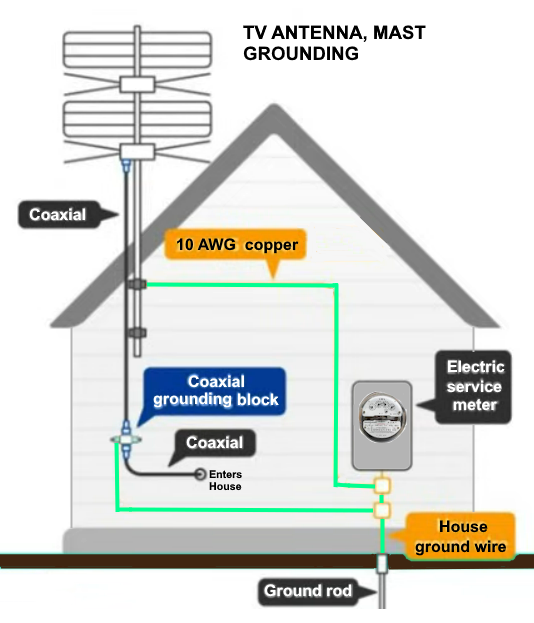
Grounding Block
The grounding block is a device designed to bleed off high voltage
spikes that reach dangerous levels that would damage your receiving
equipment. They don't directly short out the center conductor to the
ground because this would kill the signal but rather allow a small gap
that will on a continuous basis bleed off the building static charge
before it reaches dangerous levels to your equipment.
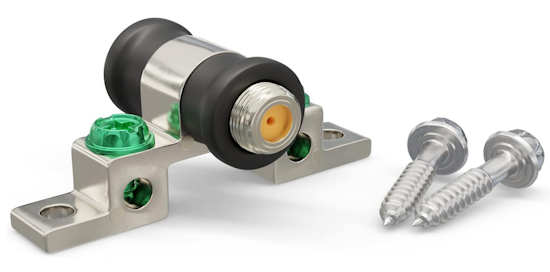
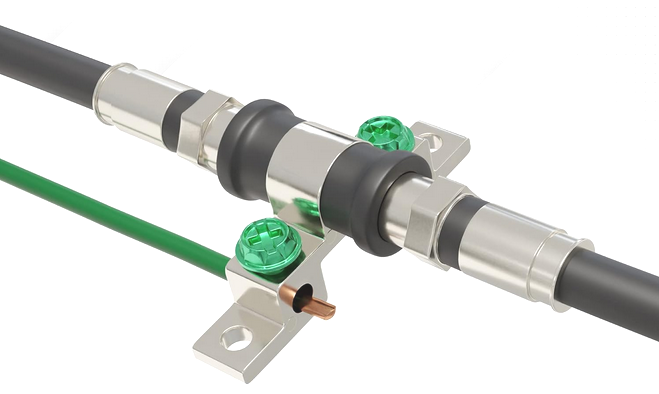
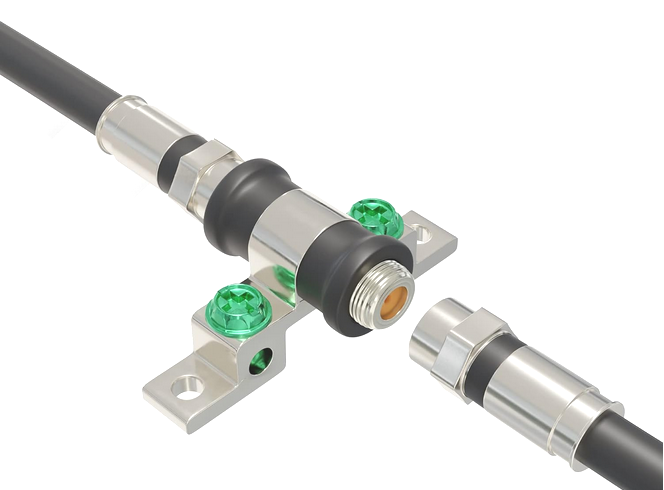
Using a grounding
block located just before the coaxial feed wire enters your building is
what is recommended to effectively reduce the probability of small
static electricity damage to your receiver. It will NOT protect against
a direct lightning hit. Both
the grounding block on the coaxial cable
(75 ohm) and a direct ground wire to the mast of the antenna should be
used.
 
GROUNDING BLOCK - Single Coaxial with F-connectors
Attach a coax grounding block, available at any electronics retailer or online,
to a point
near where the cable enters the building. Connect one length of your
coax antenna cable between the block and antenna and a second length
between the other end of the block and your receiver (TV). Then run a
length
of grounding wire from the block to a grounding rod.
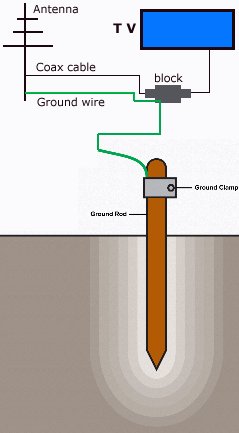
Diagram of Antenna grounding
Grounding points need to be a true earth ground (defined as a length of
pipe driven eight feet or more into the ground).
You also need to ground the antenna itself by running another length of
grounding wire between the antenna and ground point. Your antenna
itself may have special instructions for grounding; if so, be sure to
follow them. If you're not sure you've grounded your antenna correctly,
consult a professional experienced in installing antennas or the
manufacturer of your antenna itself.
It is not recommended to use water pipes, copper or not, because the
pipe may not be a true ground. Sometimes a repair has been done to the
pipes and instead of copper, PVC (plastic) was used.
Mount the grounding block as close as possible to where the 75 ohm
coaxial cable downlead enters the house. The ground wires for both the
mast and the downlead should be copper wire, number eight (8) or
larger. The downlead wire from the antenna to the grounding block and
the mast ground wire should be secured to the house spaced from four
(4) to six (6) feet apart.
Grounding the
Antenna Mast
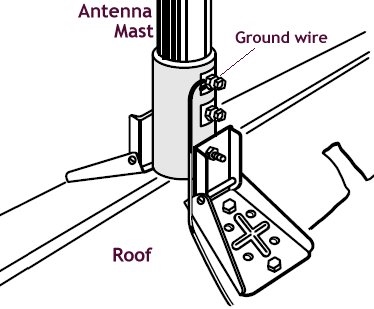
The NEC requires that the antenna mast and mount
be grounded directly. No splices or connections are
allowed in the ground wire between the mast and the
ground rod.

1 1/4 to 2 inch and wire 10 AWG to 2 AWG

Direct Burial Copper Ground Pipe Clamps (½"-1”)-Screw Thread 5/16”x18, 2-5" Wire Range.
Ideal for Connecting Grounding Electrodes to Copper Tubing & Direct Burial Electrical pipe
First, attach one end of a No. 8 or No. 10 copper ground wire to the
antenna mast. One of the bolts on the mount can be used as a fastening
point. Masts that are painted or coated
must have their coating scraped off around the area
where they contact the mount. This will ensure an
electrical connection between the mast and the
mount. It is vital to get a good, solid connection.
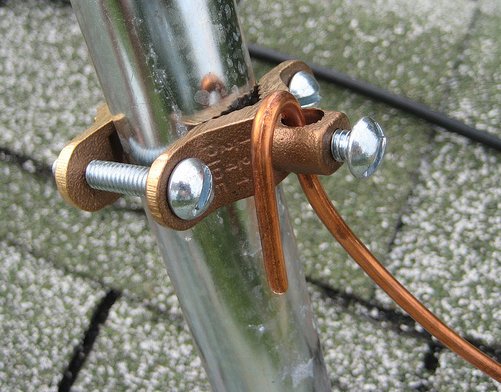
(Once the mast is attached to the mount, any scraped
off portion that is exposed should be recoated with
paint or other sealant.)
Next, run the ground wire to earth ground as directly as
possible. Standard wire staples can be used to secure
the ground wire against the side of the house. Avoid
making 90° or sharper turns with the ground wire. A
lightning charge has difficulty making such a turn and
therefore may discharge into the house. Make ground
wire bends as smooth and as gradual as possible.
The ground wire must be connected to a ground rod. Water pipes or
plumbing fixtures are not
acceptable. A good copper-coated steel ground rod
driven at least 3 to 8 feet into the ground is required.
Special clamps that provide a solid connection between the ground wire
and ground rod should be used.

Ground Rod - copper coated steel rod
Grounding
the
Transmission Line
It is not just the height of an antenna that makes it
susceptible to lightning strikes. Antennas and transmission
line can accumulate static electrical charges
that also increase the chances of lightning hitting an
installation. To properly “draw off” this static
electricity,
a small device known as an antenna discharge
unit must be included on the installation.
The antenna discharge unit (also called a “lightning
arrestor”) is connected to the transmission line at a
point close to where the transmission line enters the
house. One end of a ground wire is attached to the
discharge unit. The other end of the wire is connected
directly to the ground rod.
An antenna installation is not adequately grounded
unless both a mast ground and an antenna discharge
unit are installed correctly.
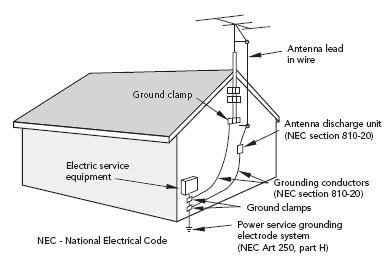
WARNING: Please take proper safety precautions if you decide to install
your antenna on the roof or another potentially dangerous location.
Consult a professional for help installing a rooftop antenna. Do not
try to install an antenna on a wet roof or one covered with ice or
snow. Always have someone else with you whenever you climb up on a
roof. If you fall, they can help or call for help.
Make sure all of your gear is plugged into a quality surge protector,
preferably one that's guaranteed for at least the amount of your
equipment cost.
If
you know a storm is approaching, it is a good idea to disconnect the
coaxial cable from the TV set.
• See
over 100 hookup diagrams
• How
to buy a TV antenna for your HDTV
• All
about Surge Protectors - Save
your electronic devices from power
spikes
• TV
antennas and reception
• HDTV
Antennas
• Surround
Sound
• Audio
and Video cable connections
• Bluray
surround sound
• Hookup
diagrams Index of 100
• DVD
RF Modulators
• HDMI
switchbox
• HDMI
Versions
• How
to hookup camcorder
• How
to install PCI card
• How
to setup surround sound DirecTV
• How
to connect PC to Stereo
• RF
Modulator
• RF
Modulator Hookups
• What is Surround
Sound? An explanation.
• How
to hookup surround sound
• Surround
Sound using HDMI
• TV
DVD VCR Hookup
• TV
hookup Cable Antenna
• VCR
and cable hookup diagrams
• VCR
Basics
• VCR
basics 2
• VCR
HDTV hookup
• Video
connection diagrams
• Video
RF Modulator
• Video
switch box
Columbia ISA Audio Video
Empowering consumers through information
columbiaisa@yahoo.com
|
|

